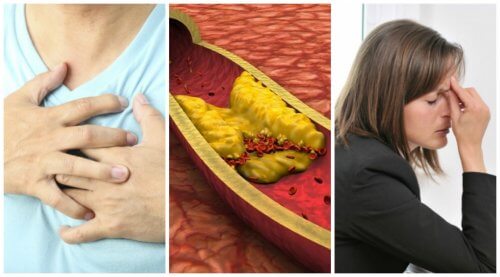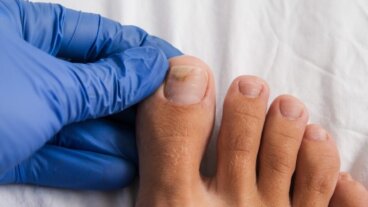Ten Symptoms of High Cholesterol You Shouldn’t Ignore


Reviewed and approved by the doctor José Gerardo Rosciano Paganelli
Those who know they have a tendency to suffer symptoms from certain health problems (glucose or high cholesterol, for example) are often concerned about it. Therefore, we’ll focus on these below.
Cholesterol is a waxy substance present in the fats of the blood. Although many only know it for its harmful effects on health, in reality, it’s essential for the optimal functioning of our body.
Cholesterol is necessary for the production of bile, which is responsible for digesting fat. In addition, it’s also responsible for the production of some hormones and helpful for your cardiovascular health.
More about the symptoms of cholesterol
The liver is responsible for producing most of the cholesterol in your body, though you can also absorb it from foods that contain cholesterol. The problem is that, even though many organs need it, too much cholesterol causes irreparable damage. In fact, high cholesterol is a potential killer.
Surely you have heard that there are several types of cholesterol, and it’s true. They are known as “good” or “bad” cholesterol, and refer to HDL and LDL cholesterol. The first (good) is made up of a high-density lipoprotein, and the second (bad) is low-density.
Both have reference values that allow an evaluation of the person’s health status. Nowadays, these are the established values:
- Total cholesterol: below 200 milligrams per deciliter. High cholesterol is considered to be anything above 240.
- HDL cholesterol: 35 milligrams per deciliter in men and 40 milligrams per deciliter in women is considered correct.
- LDL cholesterol: the normal value is less than 100 milligrams per deciliter. However, the desirable value could be lower depending on the cases.
The most worrying thing is that many people are unaware that they have it in high amounts since, in general, high cholesterol doesn’t present any strong symptoms.
In turn, this leads to the development of more serious health conditions such as arteriosclerosis, hypertension, and kidney failure. Due to this, it’s essential to know some signs that could be decisive for its detection.
1. Swelling and numbness of limbs

Swelling and a feeling of numbness in the limbs is one of the initial symptoms of high cholesterol. This reaction happens because the accumulated lipids prevent good circulation. They do this by reducing the delivery of oxygen and nutrients to the muscles.
2. Halitosis
Bad breath, known as halitosis, is one of the most common symptoms of high cholesterol. Since this substance secretes itself in the liver, too much cholesterol can create serious difficulties with digestion. As a result, you may experience dryness and unpleasant odors in the mouth.
3. Bloating and indigestion

The excess of lipids in the blood and the liver affects the metabolism, and prevents the development of the digestive process in a normal way, especially when eating foods with high fat content. For this reason, high levels of bad cholesterol (LDL) and total cholesterol usually lead to continuous episodes of indigestion and heaviness.
4. Dizziness and headaches can be signs of high cholesterol
As cholesterol builds up in the arteries, circulation gets worse, and cellular oxygenation is disrupted. This causes dizziness, loss of balance, and strong headaches.
5. Eyesight problems
It’s common for patients with high LDL cholesterol to have soft, flat, yellowish lumps in the eyes, irritation, and blurred vision.
6. Constipation
In addition, the build-up of lipids in the arteries also affects digestion. Therefore, bowel motility decreases, and episodes of constipation occur.
7. Chest Pains

8. Chronic fatigue and weakness
The feeling of weakness, fatigue, and the desire to sleep at unusual hours are usually caused by poor nutrition, excess physical activity, an illness, or high cholesterol.
9. Skin conditions
The symptoms of high cholesterol can also include skin conditions, such as hives and other similar conditions. They often manifest themselves through reddish spots, inflammation, and an uncomfortable itching sensation that is often difficult to control.
One of the skin problems associated with high cholesterol levels is eruptive xanthomatosis. It manifests as small red or yellow bumps that can appear on the face, neck, abdomen, knees, or back. They’re harmless but often cause irritation and itching.
10. More symptoms of high cholesterol: Gallbladder stones
Cholesterol plays an important role in the secretion of bile, a substance that helps digest fats and breaks down food. However, when it’s too concentrated, it can turn into crystals and hard stones that remain in the gallbladder.
For this reason, the appearance of gallstones could be a sign of high cholesterol. However, it must be taken into account that there are other determining factors and origins of this problem.
11. Erectile disfunction
In men, high cholesterol can interfere with normal sexual function. The accumulation of these lipids in the blood vessels worsens the passage of blood, as well as the one that goes to the sexual organs. Consequently, erectile function can be affected.
Guidelines to prevent high cholesterol
Having high cholesterol can be due to several reasons. In general, we associate it with a bad diet, but there are several causes, some of which cannot be modified.
- Genetic causes
- The existence of pre-existing conditions: Kidney disease, diabetes, and hypothyroidism, among others
- Taking certain medications
- Physical inactivity
- Eating habits
In some cases, it can be difficult to avoid and control hypercholesterolemia. However, some guidelines can help keep cholesterol levels at the right levels. Most of them focus on maintaining healthy lifestyle habits.
These focus on getting daily exercise, avoiding alcohol and tobacco, reducing stress, and maintaining a healthy weight. In addition, vegetables, fruits, whole grains, and healthy fats should predominate in the diet.
Pay attention to the possible symptoms of high cholesterol
Although cholesterol is a necessary substance for the body, its excessive accumulation can cause serious health problems. Most of them are related to the cardiovascular system.
This is usually a common affectation, but it only causes symptoms when it’s already in a very advanced stage. However, there are some signs or symptoms that could be linked to high lipids and that could lead to suspicion of this problem.
However, keep in mind that all the signs or ‘symptoms’ mentioned in the article can also have other causes. They do not always indicate high cholesterol levels, so it’s best to consult a doctor. The professional will carry out a physical evaluation and, if he or she considers it necessary, will request the respective tests to detect the origin of any alteration or anomaly.
In addition, as most experts point out, screening tests for high cholesterol in the blood should be done periodically. This is one of the best ways to control its evolution.
All cited sources were thoroughly reviewed by our team to ensure their quality, reliability, currency, and validity. The bibliography of this article was considered reliable and of academic or scientific accuracy.
- Atamanalp, S. S., Keles, M. S., Atamanalp, R. S., Acemoglu, H., & Laloglu, E. (2013). The effects of serum cholesterol, LDL, and HDL levels on gallstone cholesterol concentration. Pakistan journal of medical sciences, 29(1), 187. https://www.ncbi.nlm.nih.gov/pmc/articles/PMC3809189/
- Browne, R. W., Jakimovski, D., Ziliotto, N., Kuhle, J., Bernardi, F., Weinstock-Guttman, B., … & Ramanathan, M. (2019). High-density lipoprotein cholesterol is associated with multiple sclerosis fatigue: A fatigue-metabolism nexus?. Journal of clinical lipidology, 13(4), 654-663. https://www.sciencedirect.com/science/article/abs/pii/S1933287419302156
- Chen, C., Zhai, H., Huang, G., Cheng, J., Xia, F., Zhao, L., … & Lu, Y. (2018). Is lower low-density lipoprotein cholesterol associated with lower androgen and erectile dysfunction in men?. Nutrition, Metabolism and Cardiovascular Diseases, 28(12), 1304-1310. https://www.sciencedirect.com/science/article/abs/pii/S0939475318302540
- Criqui, M. H., & Aboyans, V. (2015). Epidemiology of peripheral artery disease. Circulation research, 116(9), 1509-1526. https://www.ahajournals.org/doi/full/10.1161/CIRCRESAHA.116.303849
- Elshourbagy, N. A., Meyers, H. V., & Abdel-Meguid, S. S. (2014). Cholesterol: the good, the bad, and the ugly-therapeutic targets for the treatment of dyslipidemia. Medical Principles and Practice, 23(2), 99-111. https://karger.com/mpp/article-abstract/23/2/99/207646
- Fundación Española del Corazón. Colesterol y riesgo cardiovascular. https://fundaciondelcorazon.com/prevencion/riesgo-cardiovascular/colesterol.html
- Khode, S., Tan, S. H. T., Tan, E. P. A., & Uppal, S. (2019). Xanthelasma palpebrarum: more than meets the eye. Indian Journal of Otolaryngology and Head & Neck Surgery, 71, 439-446. https://link.springer.com/article/10.1007/s12070-018-1345-0
- Ma, C., Yin, Z., Zhu, P., Luo, J., Shi, X., & Gao, X. (2017). Blood cholesterol in late-life and cognitive decline: a longitudinal study of the Chinese elderly. Molecular neurodegeneration, 12, 1-9. https://link.springer.com/article/10.1186/s13024-017-0167-y
- Mortensen, M. B., & Nordestgaard, B. G. (2020). Elevated LDL cholesterol and increased risk of myocardial infarction and atherosclerotic cardiovascular disease in individuals aged 70–100 years: a contemporary primary prevention cohort. The Lancet, 396(10263), 1644-1652. https://www.thelancet.com/article/S0140-6736(20)32233-9/abstract
- Nie, S., Chen, G., Cao, X., & Zhang, Y. (2014). Cerebrotendinous xanthomatosis: a comprehensive review of pathogenesis, clinical manifestations, diagnosis, and management. Orphanet journal of rare diseases, 9(1), 1-11. https://ojrd.biomedcentral.com/articles/10.1186/s13023-014-0179-4
- Rist, P. M., Tzourio, C., & Kurth, T. (2011). Associations between lipid levels and migraine: cross-sectional analysis in the epidemiology of vascular ageing study. Cephalalgia, 31(14), 1459-1465. https://www.ncbi.nlm.nih.gov/pmc/articles/PMC3303216/
- Sasso, F. C., Pafundi, P. C., Gelso, A., Bono, V., Costagliola, C., Marfella, R., … & NO BLIND Study Group. (2019). High HDL cholesterol: A risk factor for diabetic retinopathy? Findings from NO BLIND study. Diabetes research and clinical practice, 150, 236-244. https://www.sciencedirect.com/science/article/abs/pii/S0168822719301482
- Zárate, A., Manuel-Apolinar, L., Basurto, L., De la Chesnaye, E., & Saldívar, I. (2016). Colesterol y aterosclerosis. Consideraciones históricas y tratamiento. Archivos de cardiología de México, 86(2), 163-169. https://www.scielo.org.mx/scielo.php?pid=S1405-99402016000200163&script=sci_arttext
- Zhou, D. A., Meng, R., Li, S. J., Ya, J. Y., Ding, J. Y., Shang, S. L., … & Ji, X. M. (2018). Advances in chronic cerebral circulation insufficiency. CNS neuroscience & therapeutics, 24(1), 5-17. https://onlinelibrary.wiley.com/doi/full/10.1111/cns.12780
This text is provided for informational purposes only and does not replace consultation with a professional. If in doubt, consult your specialist.








